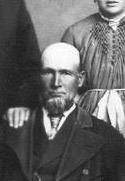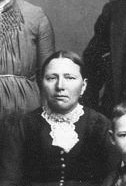Erik & Inger Marie Tode Anderson ~ Index

Erik Anderson was born 30 September, 1835 in Melgaarden, Sweden, son of Andrus Erikson and Sarah Kajsa Anderson, wealthy land owners. There were two boys and one girl in the family. After Erik finished his schooling by private tutor, his father wanted him to learn the shipping business from a brother, Johannes Erikson, who operated a freight line from Denmark to Liverpool and Australia. Erik was sent to the shipping yards in Frederikshavn to begin his training when he was seventeen. His family being well to do, he traveled in style, a dozen of everything in clothing and a gold watch.
After being away a year, he was to return home for a confirmation. A short while before the scheduled trip, the boarding house where he lived burned and he lost all of his possessions. Instead of returning to Sweden, he and Inger, whom he had met sometime before were married. He was but nineteen and Inger seventeen. He remained in Frederikshavn and didn't go to see his parents for many years. They lived in a company house. They were the parents of twelve children; eleven were born in Frederikshavn, Denmark. Five of there children died very young.

Inger Marie Tode was born 9 September, 1838 in Mygdal, Elling, (Hjørring Amt) Denmark, the daughter of Johan Henrich Frederik Tode and Christiane Christiansen. Christiane was just nineteen when she married Tode, a widower of 46 with several children. Inger was the oldest of nine children by this second marriage.
Erik was a hard workingman and was steadily promoted to better positions at the shipyards. His family was increasing; they had a fairly easy life financially. However, his disposition began to become intolerable when he started drinking. He was very strict with his family. One night he became angry with his wife and he struck her. He was stopped by the appearance of two of their children, who had died several years before. The vision frightened him so that he became a changed man from that day on. Shortly afterward they both became interested in the church and were baptized 28 March 1877.
Not much is known about Inger during her early-married life. She did have a talent for making beautiful wreaths from moss and flowers, which she and the children would gather in the forests. She managed quite a thriving business in the home. The art was handed down to her daughter Aurelia and her granddaughter Thora.
When Erik was about 35, (1870) he decided to pay a visit to his home in Sweden. It is told that he was a handsome man, dressed nattily with top hat, cane and etc. This is the way that he appeared at his home. The first person he met was his mother and he led her to believe he was a traveler. One can imagine the joy of the parents when Erik revealed his identity. They begged him to send for (his) family and they would give him a large house and a tract of land with tenants. He declined the offer. We aren't certain of Erik's reason. He must have been quite satisfied with the position at the shipyards, where he was now inspector of the finished ships. It wasn't until about five years later that he became interested in the church. This then must have been his mission in life —to accept the gospel and bring his family to Utah— not to go back to Sweden.
About the time the family became interested in the church, their daughter Aurelia, then about sixteen or seventeen, was allowed to go visit her grandparents in Sweden. She told of their beautiful home, the servants and how she was served breakfast in bed from a silver service. Among the gifts she brought home was a slip of rose in an old cream pitcher, which is now in the possession of Francis Burnham, Aurelia's granddaughter.
Inger Marie wanted to come to America. At first her husband did not want to come. Emil, their oldest living son came to Utah first to make arrangements for his mother to come. He went to a cousin by the name of Goldbrowsen in Elsinore, (which is near Richfield) and then encouraged his mother to come. Jens Peter Jensen came to the United States on the same ship as grandmother, Peter and Nancy, they were so sick and the children had the measles, so Peter Jensen took care of them, she didn't know at that time that he would be one of her future son-in-laws, he married Juliana (Aunt Jane, in) 1884. Peter Jensen and Christian Lauritzen had been home missionaries in Denmark and knew the family. Grandmother (Inger) brought Peter and Nancy to Utah by train, then to Elsinore. Aunt Nan was a young child. Grandmother (Inger) bought a house and had it fixed up, but she did not like Elsinore, so came to Salt Lake City by covered wagon. The man who owned the wagon gave aunt Nan a doll if she would sit and be quiet during the trip north. Harriet cried to come to Utah; she was sixteen years old, when a missionary brought her to Salt Lake City. The family then moved to Logan and lived on Center Street, two blocks east of the train depot, then called Johnson's Grove.
Aunt Nan remembers hiding with her doll behind the wood stove, she (was) frightened of the prowling Indians in the area. Later they moved to the Third Ward area and Erik (grandfather), William and Aurelia came to Utah to live. In the Scandinavian Countries, Christmas is a very festive season, they had been used to such. Their first Christmas was very meager; there was just enough flour and the necessities to make one small cake. Grandmother asked the family if they should eat it Christmas Eve or wait until the next day, they all chose to wait, even though the portion for each was very small. Jane came later; she said she wasn't going to be sold to the Mormons. Grandmother Inger drove a horse and nice buggy around Logan as her mode of transportation. Grandfather Erik found no work when he came, their food ran short, so he cut logs in the canyon and took care of a sawmill for a time.
Brother (Ole C.) Sonne, a missionary friend gave grandfather work, irrigating crops on his farm in Petersboro. He was given a blanket and slept on the floor of a porch; at noon he ate milk and bread. He had never done this type of work and became bitter over the situation. Erik was especially handicapped by a new language, which he made no attempt to learn and a trade that was of no use in the desert. The twenty-four years spent in their adopted country were hard ones, but as with the earlier pioneers the posterity (prospered) by their parent's sacrifices. Aunt Jane worked for one month doing housework for one and one–half bushel of apples, then the family had no sugar to take care of them. A man by the name of Fred Peterson gave Aunt Jane a ring, the first ring that she had ever owned. He gave her the ring soon after she arrived in July. The family was out of food, so Aunt Jane went to the grocery store called the Hole in the Wall, it was owned by a German lady, she had a hard time (trying) to make her understand that she wanted to trade the ring for groceries, as they didn't speak the same language, finally she made her understand, Aunt Jane went home with the groceries. Grandmother was very perturbed, as to where she had gotten them. When Aunt Jane told, she wondered what she would tell Fred about the ring. Aunt Jane told Fred that she had lost the ring and he never found out differently.
Later the family moved to the Fifth Ward area in Logan. Grandmother was a hustler and a hard worker. She fixed up a community kitchen for people coming to the Logan Temple. She fed them and many pitched tents and stayed in their yard. Sometime later, they moved to the southeast part of Logan on Canyon Road, this part of the town was called the Island; it was parallel to the Logan River. By then all were married except William, Peter and Nancy.
Erik died a very unhappy man at the age of 72, suffering from cancer. A newspaper obituary paid tribute to him, One will journey through life a long way before finding a nobler, truer man, a better citizen or neighbor.
He was truly admired for his sunny smile, kind words and industry. Erik loved music and encouraged members of the family to participate in some way; most could play an instrument or sing. Inger Marie had a very lovely singing voice and always sang with the church choir.
Erik died 21 February 1907; Inger lived eight years longer than her husband, died 28 February 1915. She was always an energetic person, so kept busy with church activities and her family. She was a temple worker for many years in the Logan Temple. She was a very generous person with whatever she had, time, talent or material possessions. She was even-tempered and good-natured always. The children said of their parents that they never heard an angry word in the home and that there was little need of discipline or punishment. During the last few years Inger suffered from high blood pressure and died one night in her chair after a family get-together.
Both are buried in the Logan City Cemetery, Logan, Cache County, Utah.
Inger Marie Tode
Inger Marie Tode was born 9 September 1838 in Denmark. Her parents were well-to-do farmers. They had three or four hired helpers on their farm. Inger Marie's Father (Johan Tode) died at breakfast one morning. Her mother (Christiane Christensen) then married one of the hired men (Anders Bengtsson). After that, Inger went to live with her grandmother, Anna M. Tode.
Later her mother, Christiane, her step-father and their two daughters came to America to live and settled in Iowa. Later they moved to South Dakota. Inger's mother did not like living in American and went back to live in Denmark, where she died and was buried. Her husband, Anders, stayed with her in Denmark until she died. He then came back to America to live.
Notes…
Nancy Anderson Garvin was Erik & Inger Marie's daughter and eleventh child in the family, as given to Margeen W. Watts in 1969.